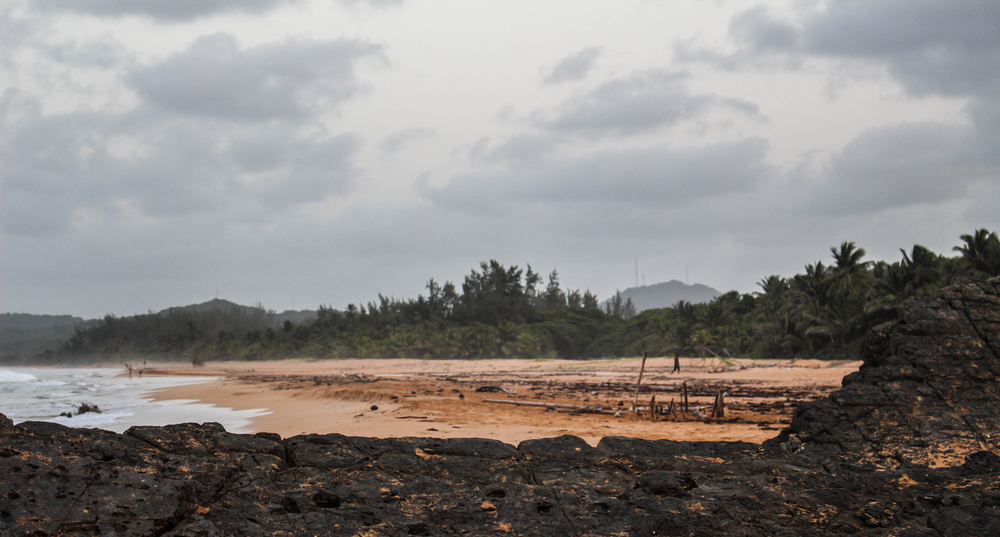This is the second post in a series on reforming national disaster policy. The first post outlined principles for reform, while this post focuses on changes to the federal disaster declaration process. The next post will focus on the division of roles between federal agencies after a disaster is declared.
What constitutes a “disaster,” how it’s measured, and whose disaster experience counts are bureaucratic decisions with material consequences. What we classify as hazard events and how we classify them has evolved tremendously since the 1920s, when Mississippi River floods first brought national attention and federal aid to natural disasters; this extended through to the landmark events of the 1994 Northridge Earthquake, Hurricanes Katrina, Sandy, Harvey, and Maria, and the recent wildfires in the West.
Scholars have long called out the challenge of defining hazard events that are socially and economically disruptive. To govern and administer assistance, the U.S. codifies disasters through a “federal disaster declaration.” But the current system for such declarations is not only inconsistent, opaque, and difficult to navigate for survivors (especially the most vulnerable), it also excludes the kinds of hazards we will increasingly face due to climate change.
Disaster declarations structure the way we track, research, and communicate about hazards and their socioeconomic impacts. The disaster declaration process begins with a state or tribal request, after a disaster exceeds their capacity to respond; it ends with the president declaring an emergency or major disaster, which opens the gates for federal agencies to transfer personnel and funding to impacted communities, as codified in the Stafford Act. The Federal Emergency Management Agency (FEMA) manages the regulations, burden of proof, and assessment of damage, and makes recommendations to the White House on whether to issue the declaration.
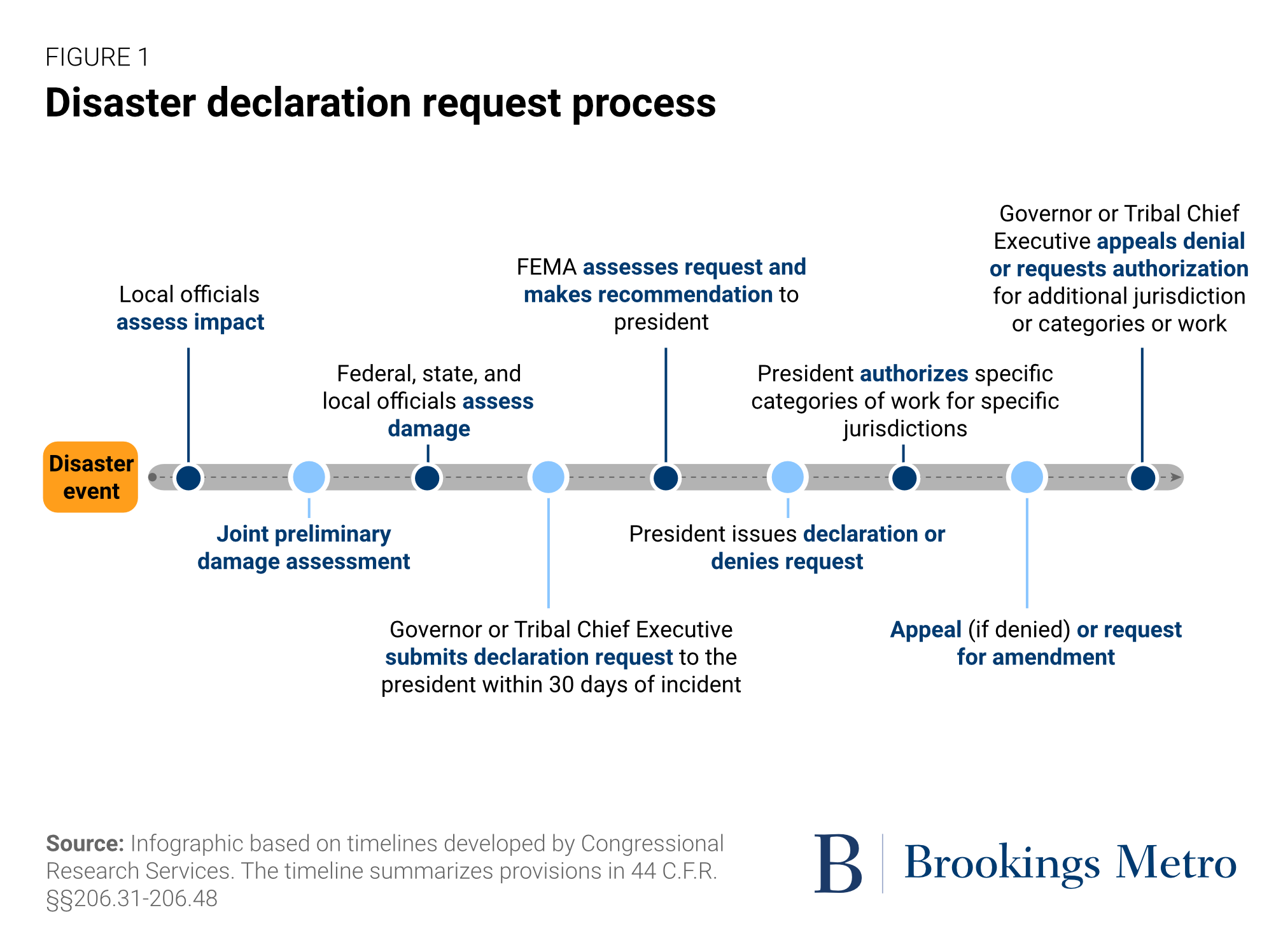
But a disaster declaration is just the first step. Both laws and program rules have built an evolving process for the federal government to assess, respond, and assist across many agencies. The declaration can immediately authorize FEMA programs such as Public Assistance, for debris clean-up, emergency services, and infrastructure rebuilding; or Individual Assistance, which provides households with limited support and services. Some of these authorizations can involve cascading triggers for short-term support, including loans for rebuilding, disaster Supplemental Nutrition Assistance Program (SNAP) benefits, and unemployment insurance. Longer-term recovery requires congressional action to authorize and appropriate funding for the Department of Housing and Urban Development’s (HUD) Community Development Block Grant Disaster Recovery (CDBG-DR) and the Economic Development Administration’s (EDA) Disaster Supplemental Funding.
Through these processes, the federal government iteratively defines and quantifies disasters. And at each juncture, challenges of effectiveness, equity, efficiency, and accounting for the environment arise. In this second blog of our series on reforming disaster response, we examine how our federal system defines disasters and the “gates” that unlock some sources of federal disaster aid but not others, and offer some solutions for reform.
Definitions
Emergency Declaration: Designation allowing initial federal aid for states’ short-term efforts for protection or rescue during and after a hazard event, or to prepare for an impending hazard. These typically only authorize Public Assistance.
Major Disaster Declaration: Designation providing funds for emergency work and permanent recovery. The declaration can authorize Public and/or Individual Assistance.
Preliminary Damage Assessment (PDA): State and federal officials assess the hazard damage and estimate the cost and number of people affected to determine a declaration decision and type.
Public Assistance (PA): FEMA aid to local governments for debris removal, emergency protection, and repairing roads, utilities, public buildings, and parks. Over the last 20 years, over 95% of major disaster declarations enabled PA. Since 2008, 91% of PA declaration requests were approved, compared to only 57% of IA requests.1
Individual Assistance (IA): FEMA aid to households for a range of needs, such as Disaster Unemployment Assistance, legal services, and crisis counseling. Basic housing repairs for uninsured damages and temporary housing are provided through the Individuals and Households Program (IHP). Over the last 20 years, only 36% of declarations enabled IA, and 57% of IA requests were approved—both significantly lower rates than those for PA.
Community Development Block Grant Disaster Recovery (CDBG-DR): HUD program for flexible long-term recovery and community development funds to local governments after a major disaster, largely targeting low-income households with unmet needs in severely impacted areas.
A formal trigger for federal involvement in a regional hazard event is reasonable and warranted. But the declaration process created decades ago has produced several unintended consequences, detailed below:
The number of federally declared disasters has increased significantly since the Stafford Act’s passage in 1988, driven by several trends beyond objectively measured damages. Figure 2 shows the number of declarations going back to 1998. The largest number of declarations was during the COVID-19 pandemic, when the president issued declarations across the country. There was also an outsized number of declarations in 2011—a year with a string of catastrophes including wildfires, hurricanes, tornadoes, and flooding.
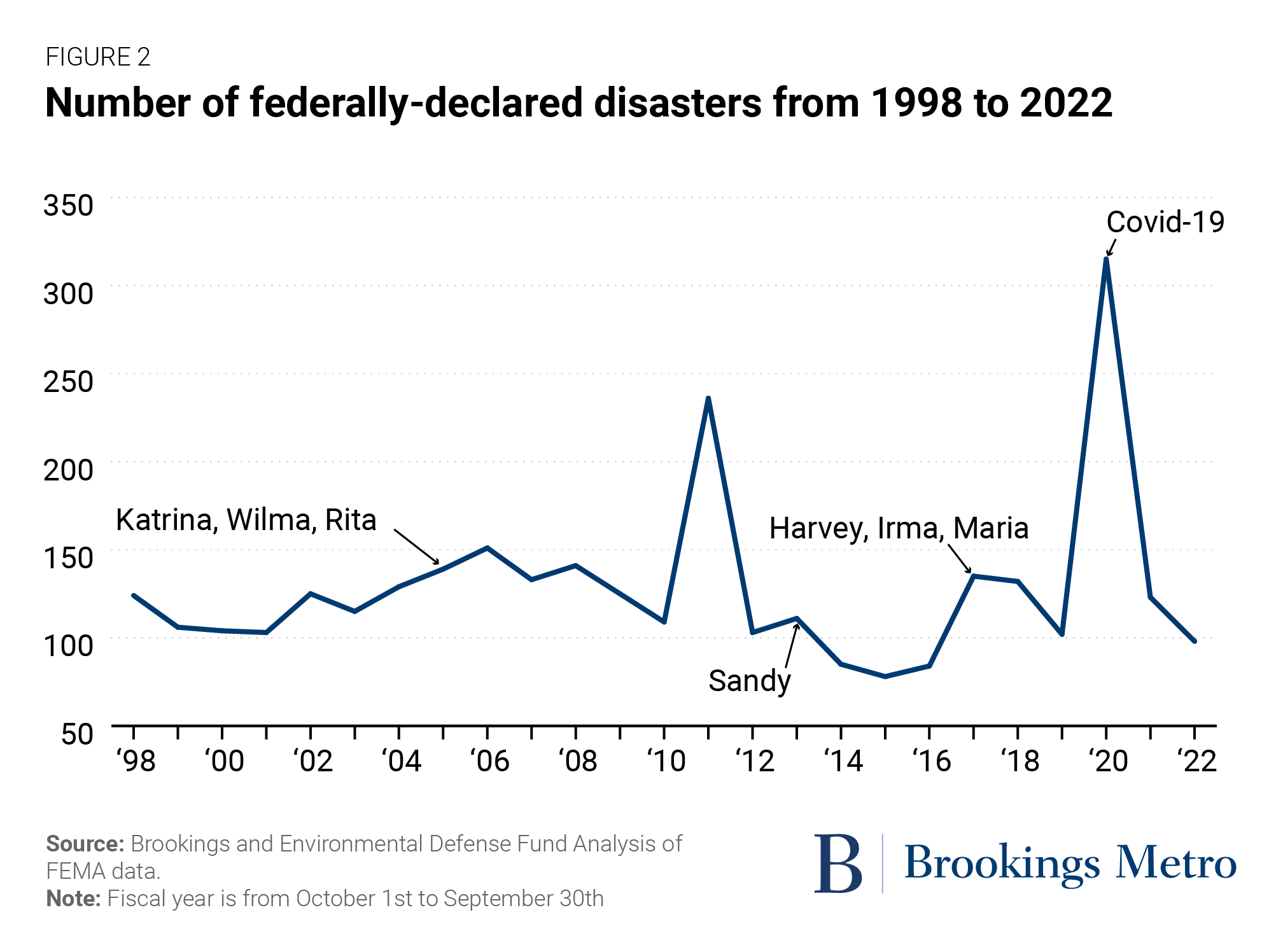
The rising number of declarations is driven not only by changing hazard frequency and continued development in high-risk areas, but also shifting political expectations surrounding the federal role in relief and recovery. This includes different forms of political bias driving governors and presidential administrations’ decisionmaking process, and differences in state governments’ capacity and experience navigating the declaration process. While there are a few examples of declarations being denied for political ends, the overall trend has been in favor of more declarations.
Recovery funding is not automatically or consistently authorized for all federal programs. A presidential disaster declaration authorizes FEMA spending from the Disaster Relief Fund (DRF), into which Congress appropriates funds for the agency to meet grant obligations in impacted areas following a declaration. The DRF receives annual appropriations that are generally sufficient to cover smaller-sized disasters or years without many events. But big catastrophes—or many disasters in one year—are difficult to estimate costs for, so the bulk of federal funding for disasters is directed through ad-hoc supplemental appropriations. Since 1992, almost three-quarters of disaster funding was through these supplemental appropriations. Additionally, the Public Assistance program typically requires some local government cost-sharing to align incentives around risk reduction, but Congress has the authority to waive it. One study suggests that Congress’ waiving of local cost-sharing across comparable disasters is increasing.
But programs outside of FEMA that serve long-term recovery are not automatically or consistently authorized. Disaster assistance by other agencies—such as HUD’s CDBG-DR and the EDA’s Disaster Supplemental Funding—are not tied to FEMA’s funding process and require separate, ad-hoc congressional authorization and appropriation. While CDBG-DR funding is substantial, there is a long timeline for making it available to state program administrators and households. This is partly because Congress must approve and appropriate CDBG-DR funding for each disaster.
Figure 3 shows annual funding for disaster relief through FEMA (both annual and supplemental appropriations) and to HUD for the CDBG-DR program. Despite growing annual DRF appropriations since 2013, supplemental appropriations are now a dominant share of overall funding. The total amount of disaster spending has been on an upward trend, with large spikes in severe disaster years and during the pandemic.
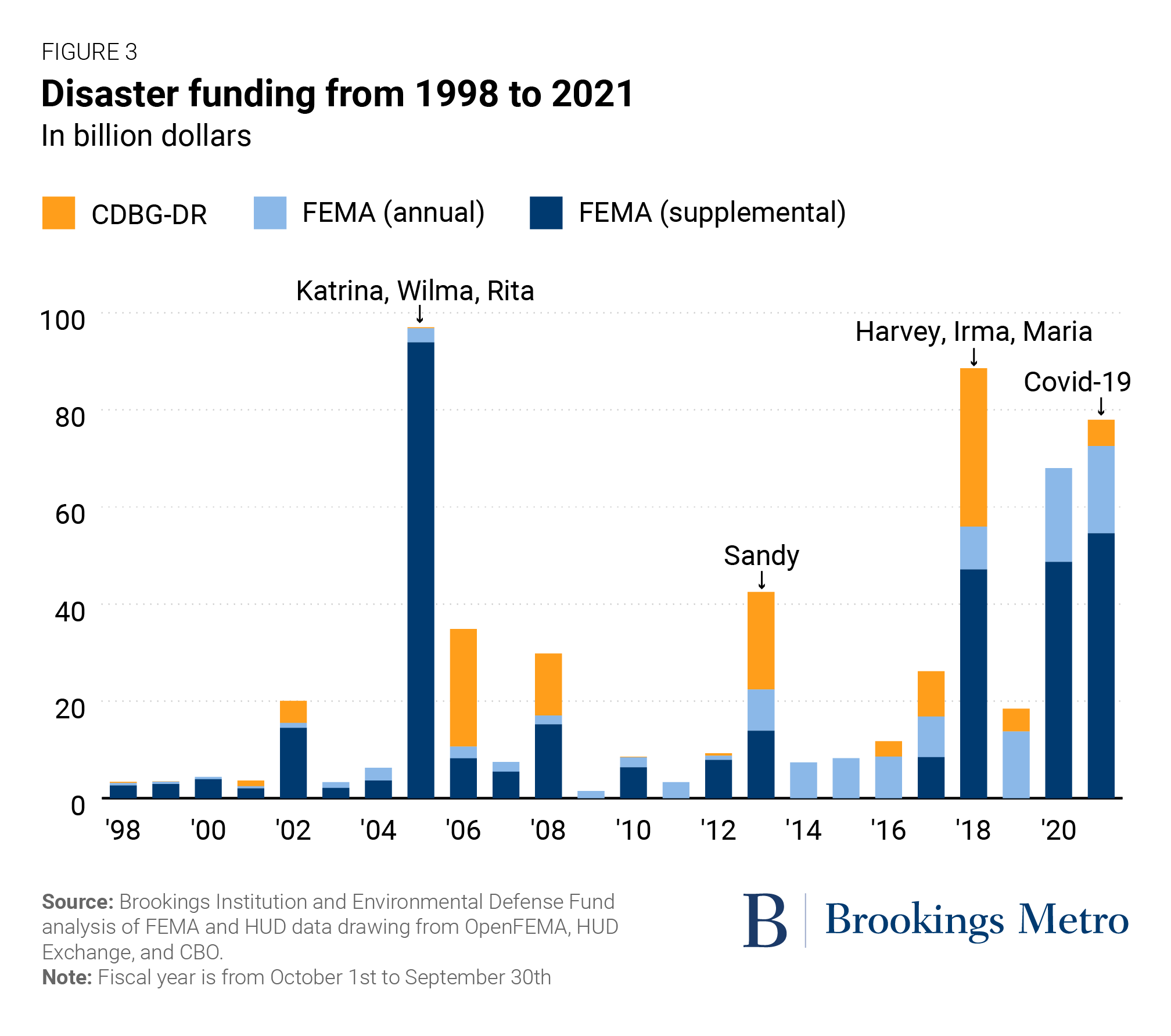
FEMA’s damage assessment methodology for declarations is not standardized or consistent. FEMA’s recommendation to the president, and the ultimate declaration decision, begins with a preliminary damage assessment (PDA)—a process through which state, federal, and local emergency officials assess the magnitude and impact of a disaster, usually through street-level accounting of infrastructure, building, and utility damage, and estimating costs for repair. While FEMA has recently made efforts to create nationally standardized processes for these assessments, they are still applied inconsistently and not transparently for external validation. Based on PDA estimates, FEMA calculates a single per capita damage threshold for determining the agency’s recommendation to the president regarding disaster declarations. Despite its important role, the PDA’s methodology and resulting assessment are often not scrutinized by policymakers.
Disasters affect populations in different ways, yet declaration decisions do not effectively account for social vulnerability. A large body of research documents that under-resourced communities and lower-income households suffer disproportionately from disasters. However, our current process does not provide these groups with support commensurate with their greater needs. The severity of a disaster’s effects on local infrastructure and property damages are the primary factors driving FEMA’s damage assessment—not social vulnerability. Because Public Assistance relies only on estimates of per capita damage, most of FEMA’s declarations are approved without explicit consideration of a community’s vulnerability. Though poverty and vulnerability data have recently been included as a factor in the declaration consideration for Individual Assistance, it is unclear how much this data influences the declaration decision.
Household-level damage assessments are flawed. Researchers have observed that household-level disaster assistance varies by socio-demographic factors, including educational attainment and ethnicity, such that short-term recovery dollars are not serving the most socially vulnerable populations. Some of this is attributable to the over-reliance on property damage in assessments, meaning that wealthier households will inherently receive more aid. But that does not explain all the differential impact.
Differential impacts are also a result of procedural inequities and the multi-step approval process required for households to receive assistance. FEMA relies on a separate assessment to determine household eligibility and the amount of support, which involves an inspector visiting the properties of households that have applied. The research, reporting, and observations from disaster recovery groups and the Government Accountability Office (GAO) suggest that assessors and other FEMA staff on the ground can be inexperienced or biased. They are incentivized to move quickly and therefore miss important damage, or they may deem disaster damage to have been pre-existing from deferred maintenance—a judgment call that is more likely to impact low-income households. The GAO has also highlighted other complications in this process for households, such as FEMA requiring that households must first be denied a Small Business Administration (SBA) loan before qualifying for assistance. The GAO found this was poorly explained to survivors and may prevent lower-income households from trying to obtain assistance.
Disaster declarations are structured to respond to acute events of specific environmental phenomena—not longer-term climate change effects. FEMA’s processes for estimating damage and the federal financial obligation typically assume that a disaster is discrete and its costs can be estimated after the fact, such for as hurricanes and wildfires. But climate change is causing more long-term stressors that don’t have clear thresholds of impact, such as heat waves and sea level rise. These hazards still require intervention, and the disaster declaration is not an effective solution. Interpretations of the Stafford Act during the COVID-19 pandemic suggest that the definition can be expanded.
All the problems with the current declaration process pose opportunities for principled reforms (Figure 4). But how can we define disasters to make our federal response more equitable and inclusive of different hazards, and create a more efficient and effective partnership between states, tribes, and the U.S. government? The following are some recommendations:
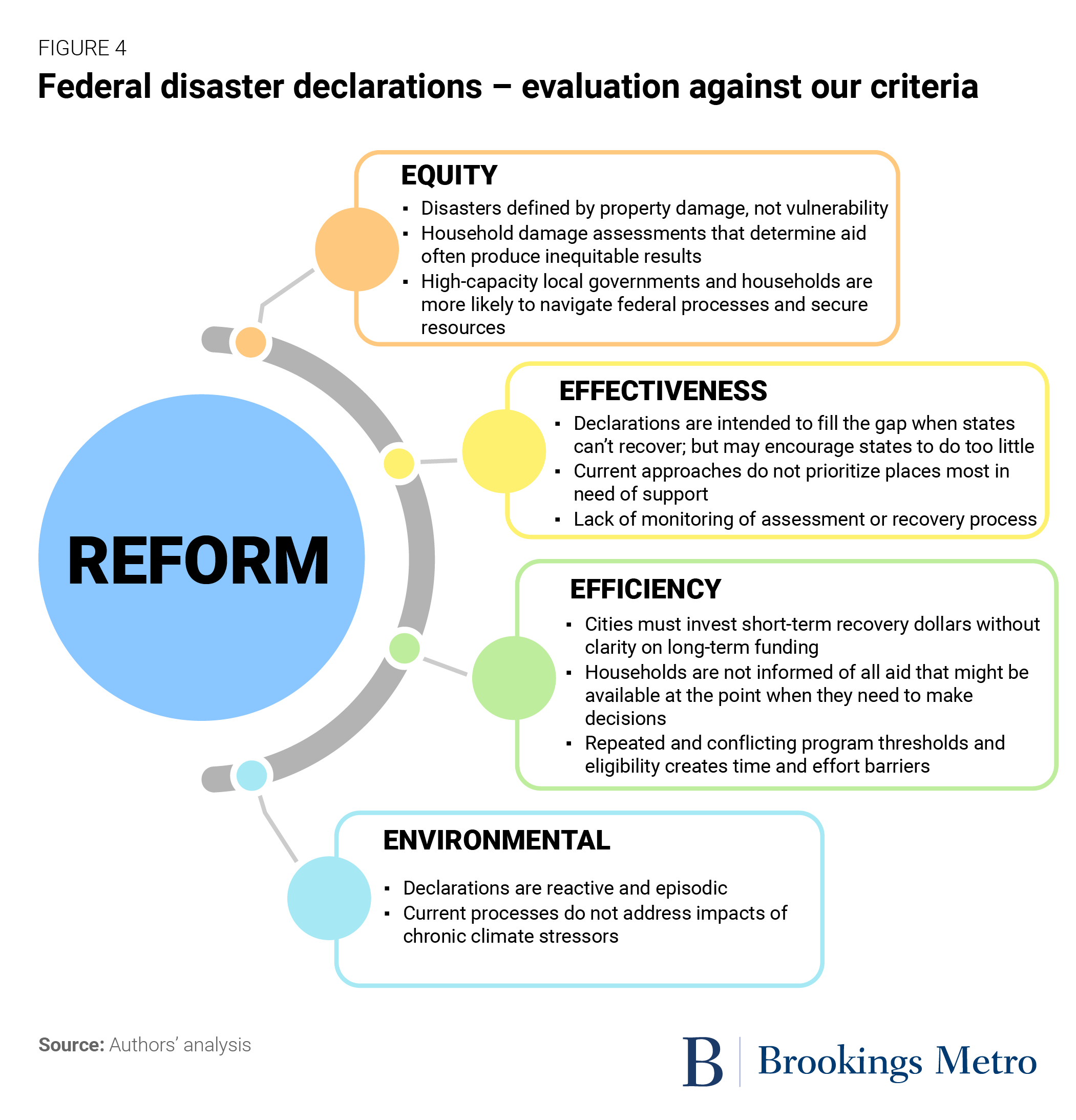
Define disasters through a lens of social vulnerability. Determinations of eligibility for federal resources and the amount given should be based not just on property damage estimates, but other metrics that capture social vulnerability. This could include loss of affordable housing, impact on low-income and very low-income households, and impacts on populations with additional needs, such as the elderly or disabled. HUD already does this through the CDBG-DR statute by allocating resources exclusively for low- and moderate-income households and estimating the magnitude of those households’ damages to define serious unmet needs. By putting more weight on these households’ property and personal losses in its assessments, FEMA programs could target greater resources for them.
To do this, the FEMA process first needs to incorporate equity measures transparently into the initial PDA. For example, a higher proportion of low-income or otherwise vulnerable households in an impacted community could increase the chances of receiving a disaster declaration based on their greater need for support. Second, equity needs to be considered in how much Public Assistance and Individual Assistance dollars are allocated once the programs are activated. Finally, FEMA should determine cost-share waivers according to community need, with congressional parameters to guide the process rather politicize it. Beginning in 2019, FEMA started collecting a “disaster impacted population profile” and publishing guidance on standard data to use, but implementation is limited to Individual Assistance requests, and is not transparently included in the declaration decision. This assessment should be foundational to future declaration considerations through a public and transparent method.
Invest in consistent, valid, and transparent damage assessments. So much of disaster response and aid deployment rely on assessing the level of damage and need in a community or household. Given the primacy of this data collection, we need widespread deployment of state-of-the-art monitoring technology; increased investment, recruitment, and training of FEMA assessors; and centralized oversight of state-level assessment plans to ensure validity. More resources should go toward household-level inspections, which are the most difficult to conduct quickly and have been shown to be prone to miscalculation and bias.
FEMA’s single per capita damage threshold for determining the agency’s recommendation to the president regarding disaster declarations does not account for local economies’ differing levels of need or populations impacted. The damage threshold should therefore be population-based or cost-adjusted to local economies.
Create a standard and transparent declaration decision process, with a continuum of severity. Local leaders should know when the federal government will step in, and trust that they are given the same support with a transparent and consistent trigger for federal disasters. To do so, emergency and disaster declarations and federal cost-share decisions should be transparent and standardized, using consistent data and public formulas across all possible federal aid programs, scaled to meet the range of need. For example, a hazard event’s damages to a given number of uninsured properties and vulnerable households would not only trigger different levels of Public Assistance and Individual Assistance, but also resources for unemployment, transportation, and education, among many other federal investments.
Changing Congress’ role in these decisions will be politically difficult, but an important step toward transparency in disaster policy. Previous proposals for standardization have met resistance, and while FEMA currently relies partially on formulas for assessing need, Congress has explicitly restricted the use of only formulaic allocation. Creating a standard process through which declarations are made will aid transparency of FEMA’s decisionmaking. Any FEMA scoring or decision logic should be published publicly, as we have done with PDAs. Formalizing a continuum of hazard severity and consequent aid thresholds does not mean less aid—just clearer amounts and types of aid early on.
Create consistent authorization of both short-term relief and long-term recovery programs. Currently, a disaster declaration only authorizes FEMA and other support programs aimed at providing short-term relief. Ensuring that long-term recovery programs in other agencies are activated in a timely way when necessary and with consistent and transparent triggers would improve coordination and planning in recovery. A key reform would be permanent authorization of CDBG-DR—a source of substantial resources for long-term reconstruction. Long-term investments may not be necessary with every event, so a graduated scale of disaster designations should include a parallel graduated scale for long-term recovery dollars that accounts for measured damages and need.
Establish consistent, transparent, and less burdensome household eligibility and determination processes. In addition to communities, households need to know what to expect from the federal aid system. The current procedural burdens and biases in assessment often lock out the households who most need assistance. A few key changes would help: attention to “deferred maintenance” judgements, easing the appeals process in terms of time and paperwork burdens, establishing higher levels of training for assessors, funding a greater number of trained assessors, and establishing incentives for assessors to undertake more thorough inspections.
Another difficulty for households is the varied and time-consuming application processes and eligibility thresholds across programs and agencies. This could be solved with a unified federal disaster application process, in which households submit their information once, their damage and need is assessed and documented, and all federal agencies reference the same documentation to determine eligibility and distribute resources. With a universal application, households can receive information about the whole set of resources available and make decisions accordingly. In the same vein, several national nonprofits in disaster recovery and housing have suggested that residents be able to pre-register for FEMA and SBA disaster loans in their tax filing, which contain most necessary background information for disaster program eligibility.
Institute clarity and consistency in the initial declaration, which is fundamental for a principled reform of subsequent federal involvement in local disasters. Disaster declarations are inherently reactive and episodic. While FEMA has a clear statutory role to designate and fund response and some recovery when they exceed states’ capabilities, the actual process of measuring, defining, and discerning the federal support needed is fraught with political and social tradeoffs. The disaster declaration process unleashes resources but also sets off other processes and decisions. These are central to the broader question of the federal role and capacity in localized hazards. Getting the declaration process right will not only define individual declarations but will reshape our entire disaster framework.
-
Acknowledgements and disclosures
The research included in this report was made possible through funding by the Walmart Foundation. The findings, conclusions, and recommendations presented in this report are those of the authors alone, and do not necessarily reflect the opinions of the Walmart Foundation.
-
Footnotes
- Calculated by authors using OpenFEMA declaration data and preliminary damage assessment records. “Natural Hazards” excludes disaster types that are under the categories of biological, toxic substances, civil unrest, and fishing losses, though the authors are conscious of the problem of identifying hazards, hazard events, and their resulting disasters as “natural” given that human causes have exacerbated many of them and the growth and distribution of human settlements determine their damages.




